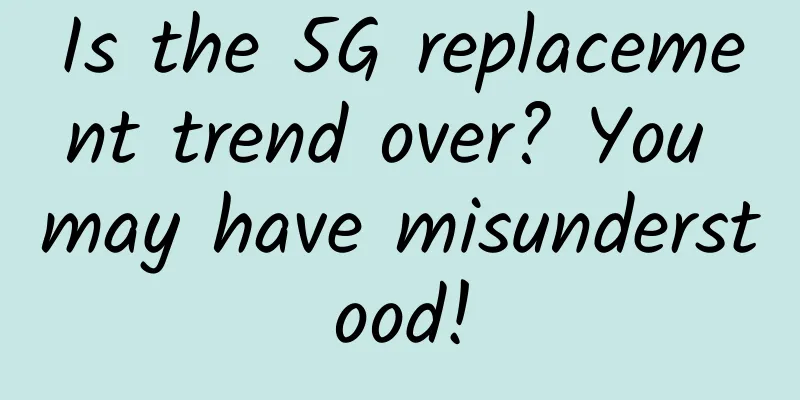Is the 5G replacement trend over? You may have misunderstood!

|
Recently, the Ministry of Industry and Information Technology released the "Economic Operation of the Communications Industry from January to July 2020" report, and a set of data attracted media attention: from January to July this year, the number of 4G users nationwide reached 128,759 million, an increase of 3.4%. In the first year of 5G, 4G users are still growing rapidly. Is the 5G replacement trend over? Many media have raised such questions. Faced with such questions, we actually need to find out who chose 4G and where these new 4G users come from.
According to the latest data from the 2018 Communications Industry Statistical Bulletin of the Ministry of Industry and Information Technology, the 4G penetration rate in 2018 was close to 84%, lower than that of leading countries and regions such as Japan (nearly 110%) and South Korea (99%). Although 4G networks have achieved good coverage after more than a year of development, some remote rural areas may not be able to achieve 4G network coverage until 2022. Therefore, more new 4G users come from these remote areas that have just achieved network coverage. So, has the 5G replacement wave arrived? According to the domestic mobile phone market operation analysis report released by the Ministry of Industry and Information Technology in July, the total shipment volume of the domestic mobile phone market was 22.301 million units, of which 5G mobile phone shipments exceeded 13.9 million units, accounting for 62.4% of the total shipment volume. Not only has it surpassed 4G in terms of quantity, but it has also basically equaled 4G in terms of the number of models. Overall, the upgrade from 4G to 5G is more like a slow and continuous trend, rather than a spurt of growth. However, the industry expects that after the second half of the year, as 5G continues to increase and prices continue to fall, 5G growth will usher in a small climax. 5G thousand-yuan phones are entering the market at an accelerated pace In the first half of 2020, although many mobile phone manufacturers released new 5G products, the prices made many consumers reluctant to buy 5G phones. However, after entering May, the prices of 5G phones began to drop rapidly. In May this year, Honor lowered the price of 5G mobile phones to 1,899 yuan, and then Redmi's new products significantly lowered the price of X series mobile phones to 1,500 yuan, and Realme followed suit and further lowered the 5G threshold to 1,399 yuan. Industry insiders analyzed that from the release of new 5G mobile phones in the past two months, the price of basic 5G mobile phones has become increasingly stable, and 5G "thousand-yuan phones" will fully open the second round of popularization of 5G terminals. The popularity of 5G mobile phones is inseparable from the reduction of costs and prices. With the relatively mature supply chains of screens, cameras, and storage, it is particularly important for chip manufacturers to provide 5G chips that meet the needs of the mid- and low-end markets. Currently, chip manufacturers such as Qualcomm, MediaTek, and HiSilicon are trying their best to transfer flagship chip specifications to mid- and low-end 5G chip solutions in order to quickly increase the penetration rate of 5G mobile phones. This year, Qualcomm has also accelerated the deployment of mid- and low-end 5G chips. In addition to the Snapdragon 765G and Snapdragon 768G with integrated 5G baseband chips, Qualcomm will also launch a 6-series 5G SoC chip. It is expected that this Snapdragon 6-series 5G processor is prepared for mobile phones priced at around 1,000 yuan. After MediaTek released the Dimensity 1000 series, it also launched the Dimensity 820 for the mid-range market. Huawei's Kirin chips have already launched 5G chips of different levels, including the 990 5G, Kirin 985, and Kirin 820. With the help of chip performance and cost advantages, Huawei's 5G mobile phones can quickly enter the popular price range. Choose more than just 5G Everyone has their own opinion on whether to switch to 5G. In the eyes of some consumers, 5G is just faster than 4G, but other consumers are more concerned about the entertainment and experience of 5G mobile phones. Mobile phone manufacturers often apply more new technologies to 5G mobile phones to improve mobile phone performance and experience. Looking at the flagship phones in the first half of this year, high-performance 5G chips, high refresh rate screens, periscope telephoto, and curved screen technologies have become standard features of flagship phones. In the second half of this year, under-screen camera solutions are also expected to be equipped on the latest 5G flagship phones. In addition, in order to address the pain points of mobile phone battery life, OPPO, vivo, and Xiaomi have launched 100W fast charging solutions, which will greatly increase the charging speed of mobile phones. A mobile phone with a 4000mAh battery can be fully charged in less than 20 minutes. Mobile phone manufacturers are also actively exploring 5G application scenarios. In April this year, Huawei announced that the Huawei P40 series mobile phones will be equipped with augmented reality maps (AR MAP). Through full-scene spatial computing and 3D map processing and other tools, it has real-time augmented reality navigation functions, which can display some virtual holographic characters at your current location, making the map more three-dimensional and immersive from a flat mode. The Redmi 10X series 5G mobile phones have more abundant AI applications, which not only improves the image quality, but also brings more ways to take photos. In addition, "video" has great potential in the 5G era. Huawei's second-generation 5G mobile phone Mate30 Pro is already equipped with a separate video lens. The OPPO Reno series uses "5G video" as its main feature. It not only has super anti-shake technology for video, but also has the ability to work online on 5G mobile networks and wifi at the same time, "targeting" the demand for short videos, live broadcasts and other video content in the 5G era. Final Thoughts On the whole, the entire mobile phone market is at a critical juncture of transition from 4G to 5G. The author believes that 4G is sufficient at this stage, but 5G will definitely provide better experience in all aspects. Whether or not to catch up with this wave of 5G phone replacement depends entirely on your own needs. |
<<: Scoping in Android and Hilt
Recommend
Have you received any orders from Baidu AiPurchasing? Is Baidu Ai Purchasing effective?
Since its launch, Baidu Ai Procurement products h...
These situations are the most likely to cause poisoning! Beware of these highly toxic wild creatures!
Audit experts: Chen Zuohong, Professor of Hunan N...
Lead pollution in the Roman Empire lowered IQ across Europe; the best time of day to drink coffee | Technology Weekly
Compiled by Zhou Shuyi and Pingsheng Lead polluti...
Experts remind: Don’t shout “Ah” when testing nucleic acid! Pay attention to these 5 details...
【Epidemic Prevention and Control Updates】 From 0:...
How to advertise on Weibo? What are the methods of Weibo promotion?
Weibo is one of the most popular and active socia...
Super powerful German Apollo intends to develop a 1,000-horsepower electric supercar
Last March, German car brand Apollo unveiled the ...
When the soil is "shouting acid", how can organic fertilizer "turn the tide"
When the soil is "shouting acid", how c...
In-depth analysis: the underlying logic of user needs
In the ups and downs of the business world, there...
"I am a little girl, but the world is big for me"! Today, let's get to know the cerebral palsy community again
Review expert: Peng Guoqiu, deputy chief physicia...
GlobalData: VR industry market size is expected to reach US$51 billion in 2030
The statistics platform GlobalData released its l...
About Tint Color Properties
Tint Color After iOS 7, UIView added a new tintCo...
The 8th session of Youlianhui TikTok Overseas Gold Mining Training Camp, Teacher Xiaobei is in charge of the practical courses that are upgraded again
The 8th session of Youlianhui TikTok Overseas Gol...
Car Talks: Brain-computer interface technology is changing the way we travel in the future
In the classic sci-fi movie "The Matrix"...
IMF: AI will affect about 40% of jobs worldwide, with jobs with higher skill requirements having greater impact
Recently, according to domestic media reports, th...
Share Bilibili’s regular money-making project, and monetize by uploading videos in batches!
I have shared with you several projects of Bilibi...









